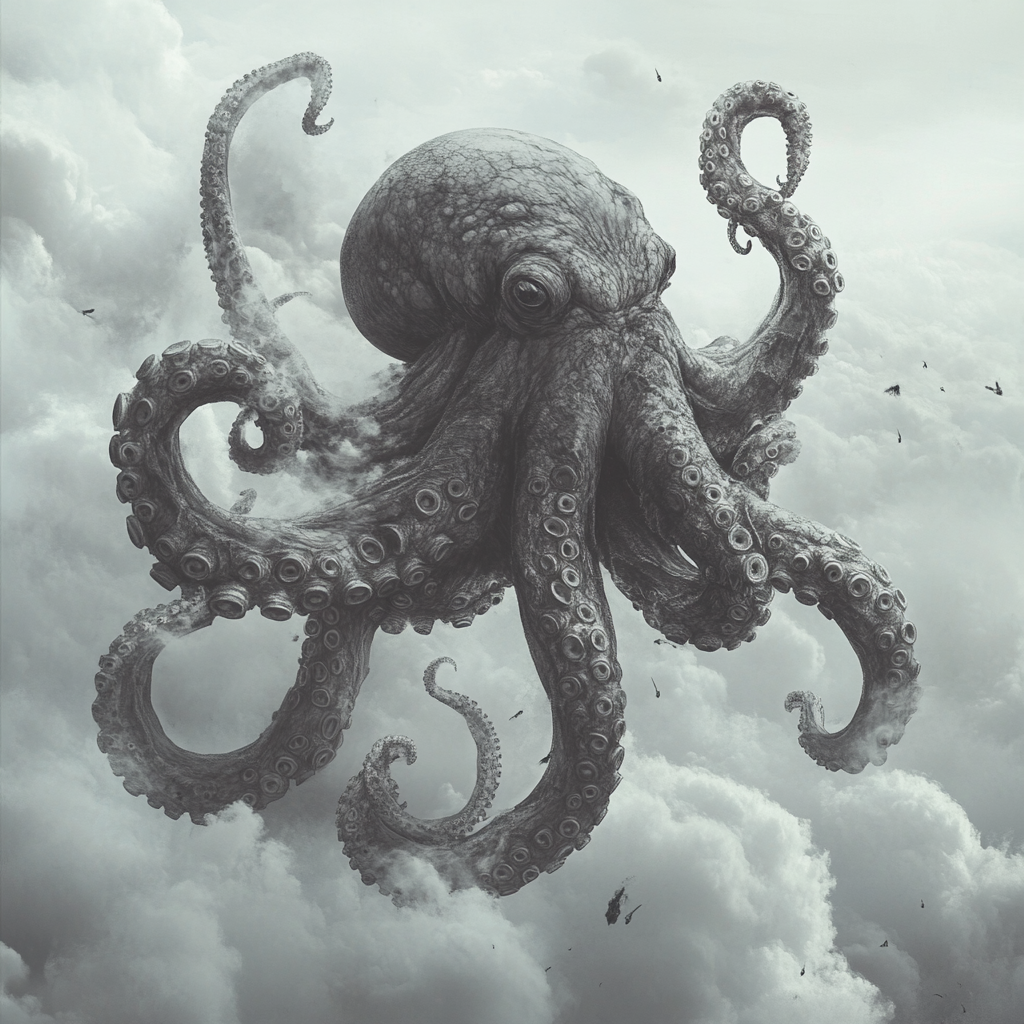Cirrosidus
Cirrosidus: Floating Octopi
Cirrosidus are fascinating, otherworldly species that glide through the clouds in search of prey. Their physiology is uniquely adapted for aerial life, relying on a combination of gas-filled bladders and jet-like expulsions to hover, steer, and propel itself across the skies.
Physical Description
Locomotion:
Floating Octopi uses specialized air bladders located within its body to stay aloft. These bladders are filled with lighter-than-air gases, likely hydrogen or helium, that it generates through its internal biology. To move, Cirrosidus employs gas expulsion jets: small, muscular openings around its body release bursts of gas with precision, allowing it to hover in place, dart quickly, or glide gracefully. By adjusting the release of gas and the angle of its tentacles, it can navigate complex air currents and even turbulent storm systems. Hunting Behavior A skilled predator, Cirrosidus primarily preys on smaller airborne creatures, such as skyfish, cloud mites, and swarms of floating insects. It uses its:
Tentacles to ensnare prey, wrapping them with surprising speed and dexterity. Bioluminescent lures to attract prey in dim or stormy conditions. Venomous suction cups to immobilize victims before consuming them. When food is scarce, it can hover motionless, conserving energy by letting itself drift with prevailing winds, waiting for prey to come within reach. Habitat and Ecology
Floating Octopi are typically found in high-altitude cloud layers, especially in regions with abundant thermal updrafts. They are often spotted near storm systems, where strong winds and updrafts carry a rich diversity of prey. Despite their fearsome hunting prowess, they are highly attuned to changes in atmospheric pressure, allowing them to avoid catastrophic storms. Behavior and Communication
Floating Octopi are social creatures, often traveling in pods of 3-7 individuals. They communicate through: Bioluminescent flashes in complex patterns. Low-frequency vibrations transmitted through the air. During mating seasons, their displays become more elaborate, lighting up the sky with mesmerizing colors and patterns. Mystical and Mythical Significance
In some cultures, sightings of Floating Octopi are seen as omens of change or blessings from the heavens. Their graceful movements and glowing displays have inspired legends of sky spirits or gods that govern the winds and weather. The Floating Octopi is not just a creature of beauty but a perfect example of adaptation, thriving in an ethereal realm far above the ground.
- Body Shape: Cirrosidus have central, bulbous bodies which house their vital organs and gas bladders. The body is semi-transparent with an opalescent sheen, reflecting light in a way that camouflages it among the clouds.
- Tentacles: Each have eight long, sinuous tentacles trailing beneath. These appendages are lined with bioluminescent dermis, which can flash hypnotic pulses to disorient prey or communicate with others of its kind.
- Coloration: Its color shifts subtly to match the hues of its surroundings, ranging from pale white to stormy gray or sunset pink, helping it blend seamlessly with the sky.
Locomotion:
Floating Octopi uses specialized air bladders located within its body to stay aloft. These bladders are filled with lighter-than-air gases, likely hydrogen or helium, that it generates through its internal biology. To move, Cirrosidus employs gas expulsion jets: small, muscular openings around its body release bursts of gas with precision, allowing it to hover in place, dart quickly, or glide gracefully. By adjusting the release of gas and the angle of its tentacles, it can navigate complex air currents and even turbulent storm systems. Hunting Behavior A skilled predator, Cirrosidus primarily preys on smaller airborne creatures, such as skyfish, cloud mites, and swarms of floating insects. It uses its:
Tentacles to ensnare prey, wrapping them with surprising speed and dexterity. Bioluminescent lures to attract prey in dim or stormy conditions. Venomous suction cups to immobilize victims before consuming them. When food is scarce, it can hover motionless, conserving energy by letting itself drift with prevailing winds, waiting for prey to come within reach. Habitat and Ecology
Floating Octopi are typically found in high-altitude cloud layers, especially in regions with abundant thermal updrafts. They are often spotted near storm systems, where strong winds and updrafts carry a rich diversity of prey. Despite their fearsome hunting prowess, they are highly attuned to changes in atmospheric pressure, allowing them to avoid catastrophic storms. Behavior and Communication
Floating Octopi are social creatures, often traveling in pods of 3-7 individuals. They communicate through: Bioluminescent flashes in complex patterns. Low-frequency vibrations transmitted through the air. During mating seasons, their displays become more elaborate, lighting up the sky with mesmerizing colors and patterns. Mystical and Mythical Significance
In some cultures, sightings of Floating Octopi are seen as omens of change or blessings from the heavens. Their graceful movements and glowing displays have inspired legends of sky spirits or gods that govern the winds and weather. The Floating Octopi is not just a creature of beauty but a perfect example of adaptation, thriving in an ethereal realm far above the ground.
Image by Midjourney AI










Comments